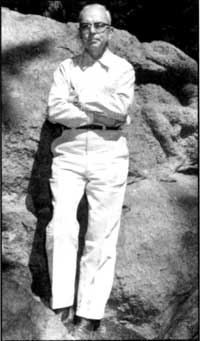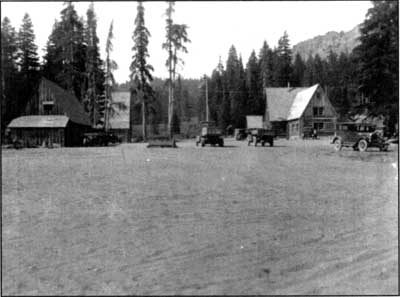|
Volume XXVIII - 1997
An Offering in the Forest
By Steve Mark
Winter can last for more than seven months at Park Headquarters. A
sign of the coming of spring appears when enough snow has melted to
reveal a figure known as the Lady of the Woods. When the snow finally
disappears, which is usually in June or July, visitors can take a short
trail located behind the Steel Information Center to view the three foot
high sculpture. Chiseled from a boulder, this unfinished work of art
blends almost perfectly into a subalpine forest of mountain hemlock. It
will be 80 years old this October and shows a few signs of age. The most
noticeable is pitting in the once smooth volcanic rock, but there are
also some details that have begun to fade with time. In spite of its
inevitable decay, the sculpture is still striking and should remain
recognizable well into the next century.
Oddly enough, the Lady of the Woods was its creator's first attempt
at sculpture. At the time of its carving, Earl Russell Bush was a 31
year old medical doctor who attended to the road crews that built the
first rim drive around Crater Lake. The season's work had largely ceased
by the end of September 1917, and he found himself with almost two weeks
at his disposal. Bush left the park on October 20th, having chisled and
hammered a recognizable form on the hard rock. He worked from memory
and, several years later, tried to explain what possessed him:

Earl Russell Bush and the Lady of the Woods,
1954.
NPS photo by C. Warren Fairbanks.
|
"This statue represents my offering to the forest, my
interpretation of its awful stillness and repose, its beauty,
fascination, and unseen life. A deep love of this virgin wilderness has
fastened itself upon me and remains today. It seemed that I must leave
something behind...if it arouses thought in those who see it, I shall be
amply repaid. I shall be satisfied to leave my feeble attempt at
sculptural expression alone and unmarked, for those who happen to see it
and who may find food for thought along the lines [of what] it arouses
in them individually. It would be sacrilege to assign a title and
decorate it with a brass plate. "
By the 1930s the statue acquired both a title (suggested by Fred
Kiser, the photographer, who seemed to always be looking for different
ways to promote the park) and a sign made of wood with raised lettering.
The idea of leading visitors there with a trail came under attack for
the first time in 1930, and is an objection which has been voiced
several times since then. Not by visitors, nor through conservation
groups, but by park employees who thought the sculpture did not belong
in a "natural" area. To them, such artifice had no place even at Park
Headquarters, where rustic architecture and naturalistic landscape
design blend aesthetics with function. Just as with stone masonry (which
is used on buildings and evident in walls, steps, curbs and even
drainage features), the carving constitutes an attempt to design with
nature. The only difference is that the sculpture's functional aspects
may not be immediately apparent to all who view it.
Whereas the function of most built features at Park Headquarters has
been put in terms of visitor services (information, restrooms) or
support facilities (employee housing, offices, equipment storage), the
Lady of the Woods serves to instruct and inspire. The sculpture can
speak to change, because 80 years ago Park Headquarters looked
considerably different than it does today. When Bush made his carving in
1917, there were only three log buildings and a barn with no attempt at
year round occupancy of the site. Less than a decade later the National
Park Service began building a headquarters where the road camp had been,
something which expanded over time to impinge on the sanctity of the
forest that Bush once knew.
The Lady of the Woods is not, however, a merely antiquarian artifact
(where the past is separated from the present) because NPS landscape
architects incorporated it within an exceptionally coherent site design,
listed on the National Register of Historic Places in 1988 as the Munson
Valley Historic District. Despite the recognition, designed landscapes
cannot be frozen in time and compromises remain apparent -- most notably
in the NPS having to utilize Park Headquarters for winter operations.
This can be seen even along the 400 foot trail to the Lady of the Woods.
Not only have the Messhall and Meathouse been adaptively reused (for
ranger operations and a trail cache, respectively), but looming in the
distance between them is the recently constructed maintenance shop -- an
especially unartistic and slavish example of form following function
when contending with snowfall.

Park headquarters at the time when Bush carved the
Lady of the Woods, ca. 1925.
NPS photo.
While change is important, character-defining features of the
historic district and (in particular the Lady of the Woods) are more
significant as representations of continuity. This type of continuity
pertains to how parks evolved as a cultural expression of interaction
with a certain setting or environment. Parks began as simple enclosures,
intended as places where the nobility exercised exclusive rights to hunt
game animals. During the 17th and 18th centuries parks fused with
ornamental gardens, the latter having originated in the Ancient World
from an urge to manipulate nature and create pleasing effects. Features
of the garden (such as plantings which imitated growth in the wild,
walks, and statuary or other structures built to evoke introspection in
those allowed access) followed Classical models at first and then became
more "natural" as the desire to emulate landscape paintings spread
throughout western Europe. The English were especially adept at creating
"landscape gardens" and developed a vocabulary for enjoying the
"picturesque" surroundings which were contrived to appear more natural
than Nature itself. When parks became public as a response to 19th
century urbanization resulting from the Industrial Revolution, the
private landscape gardens of the gentry and a newly rich class of
merchants thus became models for how to socialize a broad spectrum of
citizens by bringing them into contact with the perceived benefits of
nature.
Those familiar with the landscaped parks brought their vocabulary
with them when they went looking for "sublime" scenery. These people
followed their guidebooks and found monumental scenery which matched the
lighting effects employed by landscape painters to animate mountains,
forests, lakes, waterfalls, caves, or coastlines. Americans embraced
these aesthetic tastes at roughly the same time as the public park
movement came across the Atlantic. It is therefore no surprise that
public parks could encompass not only the countryside within or adjacent
to cities, but also the most sublime scenery, particularly where the
land remained in the Public Domain. National parks are really part of a
vast national estate, where a few of the most unusual features such as
Crater Lake can be protected for future generations to contemplate. By
seeing sublime landscapes as art, the prevailing taste allowed for
access but sought to minimize visitor impact.
Consequently, developments in the national parks have usually had
both functional and ornamental qualities, with the best being
subordinate and inspired by its surroundings.
Employees and visitors are now prevented by NPS regulations from
making artistic statements similar to Bush's, but the Lady of the Woods
is a rare window into the cultural patterns behind the origin and use of
national parks. Through this sculpture and rustic architecture elsewhere
in the park, it is possible to relate the story of how a collective
perception of nature developed through time and found expression in
gardens, parks, and finally sublime landscapes. I thought of this
inheritance and Bush's intent when these lines from J.M. Synge's
Prelude came to mind:
I knew the stars, the flowers, and the birds,
The grey and wintry sides of many glens,
And did but half remember human words,
In converse with the mountains, moors, and fens.
Reference: Richard M. Brown, The Lady of the Woods Revisited,
Nature Notes from Crater Lake 21 (1995), pp. 5-12.
|

